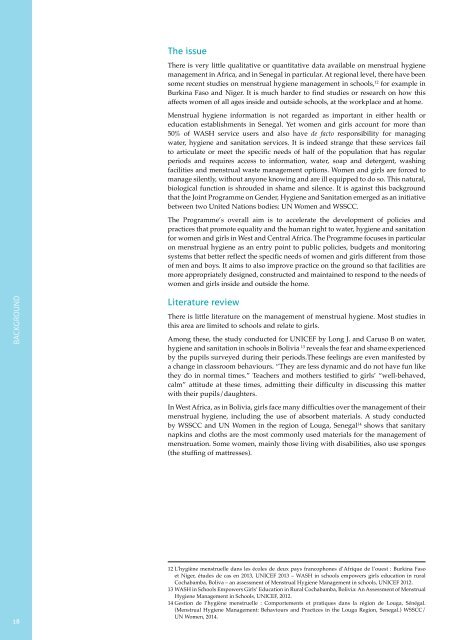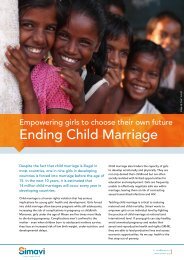1wE4FuZ
1wE4FuZ
1wE4FuZ
Create successful ePaper yourself
Turn your PDF publications into a flip-book with our unique Google optimized e-Paper software.
The issueThere is very little qualitative or quantitative data available on menstrual hygienemanagement in Africa, and in Senegal in particular. At regional level, there have beensome recent studies on menstrual hygiene management in schools, 12 for example inBurkina Faso and Niger. It is much harder to find studies or research on how thisaffects women of all ages inside and outside schools, at the workplace and at home.Menstrual hygiene information is not regarded as important in either health oreducation establishments in Senegal. Yet women and girls account for more than50% of WASH service users and also have de facto responsibility for managingwater, hygiene and sanitation services. It is indeed strange that these services failto articulate or meet the specific needs of half of the population that has regularperiods and requires access to information, water, soap and detergent, washingfacilities and menstrual waste management options. Women and girls are forced tomanage silently, without anyone knowing and are ill equipped to do so. This natural,biological function is shrouded in shame and silence. It is against this backgroundthat the Joint Programme on Gender, Hygiene and Sanitation emerged as an initiativebetween two United Nations bodies: UN Women and WSSCC.The Programme’s overall aim is to accelerate the development of policies andpractices that promote equality and the human right to water, hygiene and sanitationfor women and girls in West and Central Africa. The Programme focuses in particularon menstrual hygiene as an entry point to public policies, budgets and monitoringsystems that better reflect the specific needs of women and girls different from thoseof men and boys. It aims to also improve practice on the ground so that facilities aremore appropriately designed, constructed and maintained to respond to the needs ofwomen and girls inside and outside the home.BackgroundLiterature reviewThere is little literature on the management of menstrual hygiene. Most studies inthis area are limited to schools and relate to girls.Among these, the study conducted for UNICEF by Long J. and Caruso B on water,hygiene and sanitation in schools in Bolivia 13 reveals the fear and shame experiencedby the pupils surveyed during their periods.These feelings are even manifested bya change in classroom behaviours. “They are less dynamic and do not have fun likethey do in normal times.” Teachers and mothers testified to girls’ “well-behaved,calm” attitude at these times, admitting their difficulty in discussing this matterwith their pupils/daughters.In West Africa, as in Bolivia, girls face many difficulties over the management of theirmenstrual hygiene, including the use of absorbent materials. A study conductedby WSSCC and UN Women in the region of Louga, Senegal 14 shows that sanitarynapkins and cloths are the most commonly used materials for the management ofmenstruation. Some women, mainly those living with disabilities, also use sponges(the stuffing of mattresses).1812 L’hygiène menstruelle dans les écoles de deux pays francophones d’Afrique de l’ouest : Burkina Fasoet Niger, études de cas en 2013, UNICEF 2013 – WASH in schools empowers girls education in ruralCochabamba, Boliva – an assessment of Menstrual Hygiene Management in schools, UNICEF 2012.13 WASH in Schools Empowers Girls’ Education in Rural Cochabamba, Bolivia: An Assessment of MenstrualHygiene Management in Schools, UNICEF, 2012.14 Gestion de l’hygiène menstruelle : Comportements et pratiques dans la région de Louga, Sénégal.(Menstrual Hygiene Management: Behaviours and Practices in the Louga Region, Senegal.) WSSCC/UN Women, 2014.



